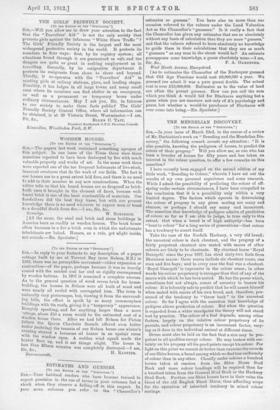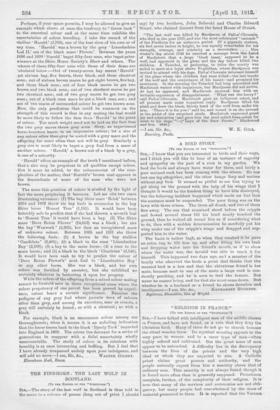THE MENDELIAN DISCOVERY.
[To THE EDITOR OP THE " SPECTATOR...1 Sin,—In your issue of March 23rd, in the course of a review of Mr. Darbishire's work on " Breeding and the Mendelian Dis- covery," the following remark arrests my attention: "It is also possible, knowing the pedigrees of horses, to predict the colour of their progeny." Will you allow me, as one who has been a breeder of horses for fifty years and has taken an interest in the colour question, to offer a few remarks on this assertion P I have recently been engaged on the second edition of my little work, "Breeding to Colour," wherein I have set out the results of my own personal experience and some research. While I admit the possibility of predicting the colour of off- spring under certain circumstances, I have been compelled to the conclusion that it is a possibility only within a very limited degree. The factors which operate in determining the colour of progeny in any given mating are many and obscure, or perhaps I should say many and inconstant. The assertion that knowledge of pedigree admits of prediction of colour, so far as I am able to judge, is true only to this extent, that when a breed is of high antiquity—has been "bred to colour " for a long series of generations—that colour has a tendency to assert itself. Take the case of the Norfolk Hackney, a very old breed: the ancestral colour is dark chestnut, and the progeny of a fairly prepotent chestnut sire mated with mares of other colours are likely to be chestnuts. My chestnut horse Royal Danegelt,' since the year 1897, has sired sixty-two foals from Elsenham mares : these mares include six chestnut roans, one roan and five bays; and in every case the foal was a chestnut Royal Danegelt' is impressive in the colour sense ; in other words his colour propotency is stronger than that of any of the mares with which he has been mated. He has the power which, sometimes but not always, comes of ancestry to bestow his colour. It is tolerably safe to predict that he will assert himself when mated with mares of his own breed, and, therefore, pos- sessed of the tendency to " throw bank " to the ancestral colour. So far I agree with the assertion that knowledge of pedigree allows prediction of colour. But when the question is regarded from a wider standpoint the theory will not stand test by practice. The oolour of a foal depends, among other factors, largely on the relative colour propotency of its parents, and colour prepoteney is an inconstant factor, vary- ing as it does in the individual animal at different times.
Stress must also be laid on the fact that a sire may be pro- potent in all qualities except colour. He may bestow with cer- tainty on his progeny all his good points except his colour. For light on this point we cannot do better than examine the records of our Shire horses, a breed among which we find loss uniformity of colour than in any other. Classify under colours a hundred horses taken at random from the Shire Horse Stud Book and more colour headings will be required than for a hundred taken from the General Stud Book or the Hackney Stud Book. Further, our Shire horses have in their veins the blood of the old English Black Horse, thus affording scope for the operation of inherited tendency in mixed colour matings. Perhaps, if your space permits, I may be allowed to give an example which shows at once the tendency to " throw bark" to the ancestral colour and at the same time exhibits the uncertainties of colour breeding. I take the record of the stallion ' Harold' (3.703), one of the best sires of his own or of any time. ' Harold' was a brown by the grey Lincolnshire Lad IL' out, of the black mare Flower.' Between the years 1886 and 1899 Harold' begat fifty-four sons, who begat prize- winners at the Shire Horse Society's Show and others. The colours of these fifty-four eons with those of their dams are tabulated below :—Out of twenty-seven bay mares ' Harold' 4ot sixteen bay, five brown, three black, and three chestnut sons; out of sixteen brown mares he got eight brown, five bay, and three black sous; out of four black mares he got two brown and two black sons; out of two chestnut mares he got two chestnut sons; out of two grey mares he got two grey sons ; out of a black roan mare ho got a black roan son ; and out of two mares of unrecorded colour he got two brown sons. .Now, the only prediction that could be ventured on the strength of this record is that in any mating the foal would be more likely to follow the dam than ' Harold' in the point of colour. Too much weight need not be laid on the fact that the two grey mares threw grey suns. Grey, as experienced horse-breeders know, is an impressive colour; let a sire of any colour other than grey be mated with a grey mare and the offspring far more often than not will be grey. Similarly a grey sire is most likely to beget a grey foal from a mare of another colour. ' Harold,' a brown out of a black by a grey, is one of a minority.
Harold' offers an example of the truth I mentioned before, that a sire may be prepotent in all qualities except colour. 'But it must be added, to the enhancement of the com- plexities of the matter, that' Harold's' brown coat appears in the descendants of some of his sons who were not brown.
The more this question of colour is studied by the light of fact the more perplexing it becomes. Let we cite two cases illustrating extremes : (1) The bay Shire mare ' Brisk' between 1874 and 1882 threw six bay foals in succession to the bay Shire horse ' Honest Tom' (1,105). It would have been tolerably safe to predict that if she had thrown a seventh foal to' Honest Tom' it would have been a bay. (2) The Shire mare 'Dove Eaton Flower' (14,623) was a black ; her sire the bay' Waxwork' (2,305), her dam an unregistered mare of unknown colour. Between 1885 and 1891 she threw the following foals : (1) A brown to the bay stallion ' Candidate' (2,405); (2) a black to the roan Lincolnshire Boy' (3,188); (3) a bay to the same horse; (4) a roan to the same horse; and (5) a black to the black Charlatan' (3,540). It would have been rash to try to predict the colour of 'Dove Eaton Flower's' next foal to 'Lincolnshire Boy' or any other horse. She was a black, and her own colour was fortified by ancestry, but she exhibited no certainty whatever in bestowing it upon her progeny.
While the colour of the offspring from a mixed colour mating cannot be foretold save in those exceptional cases where the colour prepotenoy of one parent baa been proved by experi- ence, colour bears a certain significance. Examine the pedigree of any grey foal whose parents were of colours other than grey, and among its ancestors, near or remote, a grey will certainly be found; so with a chestnut ; so with a black.
For example, black is an uncommon colour among our thoroughbreds; when it occurs it is an unfailing indication that the horse traces back to the black Byerly Turk' imported into England in 1689. The colour lies dormant for a series of generations to reappear with a fitful uncertainty wholly unaccountable. The study of colour in its relations with heredity is at once interesting and baffling. But I feel that I have already trespassed unduly upon your indulgence, and
will add no more.—I am, Sir, &c., WALTER GIL13EY. Elsenhans Hall, Essex.







































 Previous page
Previous page